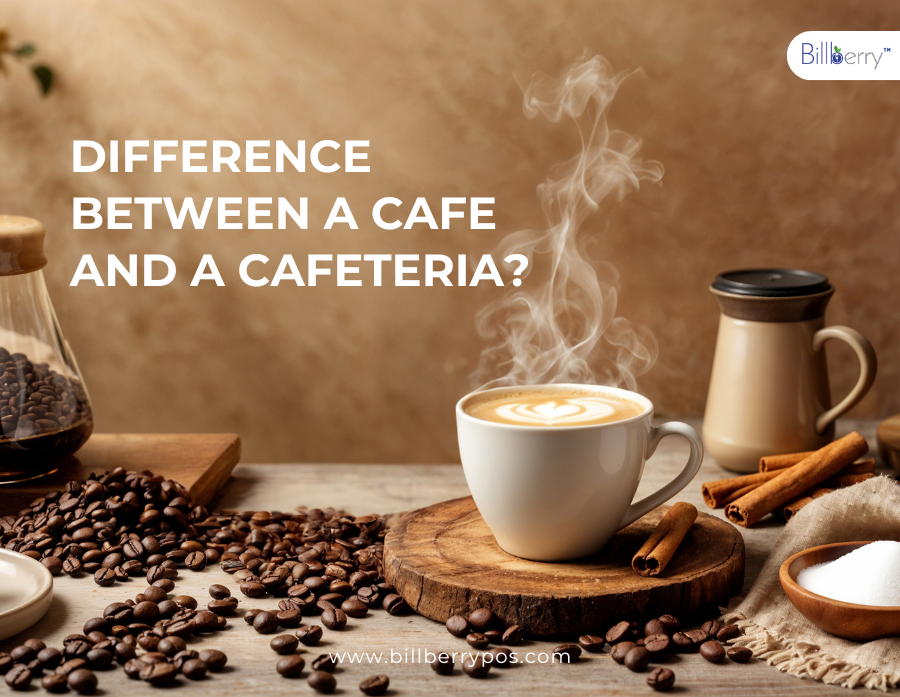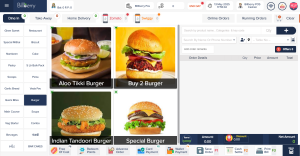Confused between a cafe and a cafeteria? Let’s unpack everyday difference between the two, through stories, settings, and the way we eat.
It’s a lazy Sunday. You grab your book, sling your laptop bag over your shoulder, and head to that little place with fairy lights and the smell of roasted coffee beans. You find a cozy corner, order a cappuccino, maybe a croissant, and start your day.
Now, picture this:
It’s 1:15 PM on a Monday. You’re in your office building. The elevator doors open on the 3rd floor and there it is, your cafeteria. You pick up a tray, grab a thali, maybe a samosa on the side, and sit wherever there’s space. You’ve got 25 minutes before that meeting starts.
Both serve food. Both have tables. So what really is the difference between a cafe and a cafeteria?
Let’s go deeper than the dictionary.
1. The Vibe: Experience vs. Efficiency
You don’t go to a cafe just to eat. You go for the pause.
Whether it’s a solo escape, a catch-up with a friend, or a quiet place to work, cafes are about how you spend your time.
~ The music? Handpicked.
~ The furniture? Rustic or aesthetic.
~ The food? Limited, but curated.
~ The people? Often lingering.
In contrast, a cafeteria is designed for movement.
It’s where you refuel, not reflect. There are no soft cushions or indie playlists, just rows of tables and fast-moving queues. It’s built for volume, not vibe.
2. The Way You Order: Human Touch vs. Mass Serving
At a cafe, you either place your order at a counter or with a server. They’ll smile, ask if you want oat milk, maybe suggest their new sandwich. There’s conversation.
But in a cafeteria, you’re part of a system.
You grab a tray. Walk the line. Point to what you want. Someone behind the counter slaps it onto your plate. It’s a process designed to serve 100 people in 15 minutes.
3. What’s on the Plate: Small Plates vs. Full Meals
Let’s talk about the food.
Cafe food is light. Sandwiches, pastas, brownies, muffins, salads, smoothies.
It’s snacky, Instagrammable, and often expensive for the portion.
Cafeteria food is practical. Rice, curry, rotis, sabzi, daal, some dessert. It’s about eating a full meal and moving on.
Here’s a personal example:
When I was in college, the cafeteria was survival, rice, two sabzis, and a rushed lunch before my next lecture. But the cafe outside campus? That’s where we went after exams, to split a cold coffee and gossip for hours.
4. Who Runs the Place: A Business vs. A Facility
This one’s important for business owners.
Cafes are privately owned, often branded, and exist to make a profit through ambiance + food.
They rely on customer loyalty, word of mouth, and Instagram check-ins.
Cafeterias are typically part of an organization, schools, colleges, companies, hospitals.
They’re not built for branding; they’re built for bulk. Often outsourced to caterers who manage cost, quantity, and speed.
5. How You Feel There: You vs. the Crowd
You feel seen in a cafe.
You might get to know the barista. You might have a “usual.” It’s intimate, intentional, and identity-driven.
In a cafeteria, you’re one among many. You don’t linger. You don’t get “your table.”
You eat, and you leave. That’s the unspoken rule.
Running a Cafe? Here’s How Billberry POS Makes It Effortless
If you own or manage a cafe, you already know that it’s not just about brewing great coffee, it’s about creating a seamless, memorable experience for your customers. From quick order-taking to managing customizations, table service, online orders, loyalty programs Billberry’s Cafe POS system is built to handle it all. Designed for the hustle of cozy, high-expectation spaces, it helps you keep your service fast, your operations smooth, and your customers coming back for more.
Why This Difference Matters (Especially If You’re in F&B)
If you’re someone thinking of opening a food business, or improving your current one, understanding this difference isn’t trivial. You’re not just choosing what to serve.
You’re choosing:
~ The kind of people you want to attract
~ The pace of service you’ll offer
~ The systems you’ll need (staffing, inventory, billing)
~ The experience you want to sell
And this is where Billberry POS can support both ends of the spectrum. Whether you’re designing a beautiful cafe experience or managing high-volume cafeteria operations, our system adapts to your process.
Because food is more than food. It’s flow, people, and rhythm.
Final Thoughts:
A cafe and a cafeteria may sound similar, but they’re two different worlds when it comes to intention, interaction, and impact.
So the next time someone says, “Let’s grab a bite”, ask yourself: “Do I want to chill… or just chew?”







